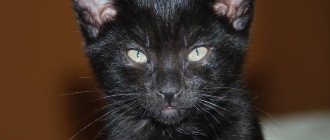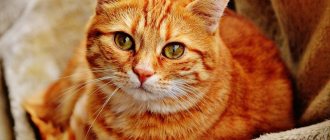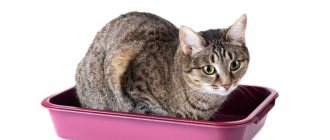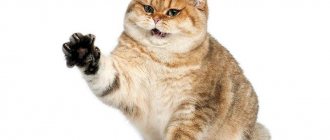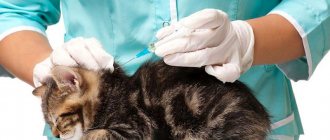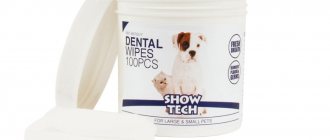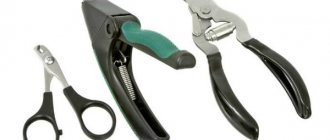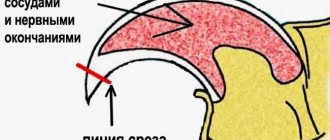Alena Igorevna Goncharenko
veterinarian Petstory
In this article we will look at how to give a cat an enema at home, and most importantly, whether it is worth doing it yourself. There are many reasons for having to give a pet an enema, but the lack of stool does not always indicate constipation. Let's take a closer look at this.
In what cases is it necessary to give an enema?
The main indication for performing an enema is a prescription from the attending physician. If you suspect your cat is constipated, you should first contact a professional for a diagnosis. Usually, not having a bowel movement for a few days is not a life-threatening condition, and you still have time to find a doctor to examine your pet. If the diagnosis is confirmed and the doctor prescribed this procedure for constipation, then you can give the cat an enema at home. It is usually performed no more than twice a week, but each case is unique and recommendations may vary.
What not to do
It is recommended to carry out the procedure on your own only after consultation with a specialist:
- Also, you should not choose enema compositions on your own. One solution may be suitable for a cat, but the same mixture may not be administered as an enema to children.
- If it is visually determined that the fluid does not enter the intestine, we immediately stop the procedure. This may indicate that the stool is very thick, possibly hairballs. This can also be a sign of an internal tumor.
- When an animal begins to violently resist, you should not use force. It is enough to give or inject a sedative to the cat - the procedure will become much easier.
An important point: if after 1-2 procedures the animal’s defecation is still difficult and only water comes out, immediately contact a specialist.
When should you not give an enema?
Under no circumstances should you give an enema before your animal has been examined by a doctor. Often, constipation can mask other health hazards. Very often, owners confuse the lack of urination in an animal with constipation due to a blockage in its urethra. Cats, according to the owners, behave typical of constipation: they run into the litter box all day without any success, scream, and lie down on the cold floor. If you give an enema to a cat in this condition, not only will his health not improve, but there is also a high risk of rupture of the bladder, which can lead to the rapid death of the animal. You should also not give an enema to a pet with mechanical obstruction of the gastrointestinal tract. In this case, administering an enema will not facilitate bowel movement, and the movement of a foreign body can lead to injury and rupture. With constant chronic constipation, a cat may develop a condition called megacolon. This is an excessive expansion of the rectum, in which feces begin to accumulate, like in a pocket. In this condition, an enema can be performed, but it is possible that this will not bring any success and surgical intervention will be required.
Also contraindications for giving a cat an enema are: bleeding in the gastrointestinal tract, acute inflammatory diseases, intestinal neoplasms, rectal prolapse, the first days after surgery on the gastrointestinal tract. This procedure should be performed with caution on pregnant and lactating cats. Animals with cardiovascular diseases are at risk. If you are unsure about giving your pet an enema, consult an outside physician and get a second opinion.
What should alert the owner?
But the first signs in which constipation can be suspected, and which tell the owners that cleansing treatment is necessary, are very eloquent. This:
- strange behavior of the cat when visiting the litter box: uncharacteristic sounds. Plaintive meowing, frequent but “idle” trips to the litter box;
- hard excrement, sometimes there is mucus and blood in the tray;
- absence of excrement for one or two days, whereas usually the cat poops a couple of times a day;
- poor appetite for a long time;
- anxiety during caresses, especially dissatisfaction is caused by touching the abdominal area;
- upon palpation, the animal’s abdomen may tense and be hard;
- the cat behaves sluggishly or restlessly: does not play, does not lick itself, tries to hide, moans or makes plaintive sounds.
Leaving feces inside for a long time poisons the animal’s body.
What types of enemas are there?
Enemas can be divided into:
- Medicinal
These include cleansing and medicinal enemas. Cleansing enemas are used to treat constipation. They are oil (with an oil solution), hypertonic (with a saline solution) and microenemas (Microlax enema). Medicinal enemas can contain various drugs and be used for different purposes. For example, they may use herbal infusions with anti-inflammatory properties. Cold enemas are used to reduce body temperature, and enemas with an anticonvulsant drug are used for epileptic seizures.
- Diagnostic
Such enemas can be used to inject a contrast agent into the rectum to diagnose tumors, ruptures, and diverticula. These enemas are also used in preparation for endoscopic examination of the rectum.
How to give an enema to a cat: step-by-step instructions
Preparing for the production
In order to give a cat an enema at home, preliminary preparation will be required. It is better to put all the necessary items in advance in convenient and accessible places. If you start a procedure with a cat and in the process realize that the item you need is in another room, catching a frightened pet a second time may be an overwhelming task. It is also better to carry out the preparation process without the presence of a cat in this room, so that it does not sense something is wrong in advance and hide. It is advisable to carry out this procedure with an assistant; it can be extremely difficult for one person to hold the cat and do the enema at the same time. So, for the procedure you will need:
- Diapers or newspapers. They are very convenient for covering the floor, so that you can then collect everything and throw it away without much washing.
- Rubber syringe. Its size depends on the size of the pet and the volume of the enema prescribed by the doctor.
- Petrolatum. It is useful for lubricating the syringe spout.
- Warm water. It is necessary to heat the water to approximately 30 degrees. To avoid mistakes, it is better to use a thermometer. High temperatures will cause burns, and low temperatures will cause intestinal spasms.
- Large capacity. A basin or tray is suitable for the cat to go into after the procedure.
- Gloves. You should not neglect your own hygiene, and it is better to carry out all manipulations with gloves.
- Towel or blanket. You will wrap the cat in it so that it does not injure anyone during the procedure.
Preparation of the solution
The solution must be prepared strictly according to the doctor's prescription. Different medications and volumes of fluid may be needed to solve different problems. Let's give an example of how to prepare the most commonly prescribed solution in order to properly administer an enema to a cat:
- fill a large container with 200 ml of water;
- heat it to a temperature of 30 degrees, check with a thermometer;
- add 20 ml of Vaseline oil;
- stir well to emulsify, but do not foam.
Hurry up, choose a box and find out what gift awaits you
Discount on pet insurance
Promo code copied to clipboard
Enema technique
When all the equipment and solution are ready, you can begin the actual procedure. To begin, wrap your cat in a towel. Lay out a towel and stand or place the cat in the center. Wrap the cat: first with one end of the towel, then with the other on top. If the cat bites, it is better to cover the head with a towel. It is also worth covering the hind legs, as cats are very deft at using their claws on them. Leave only the butt and tail exposed. Next, in order to properly give an enema to a cat with constipation, you must follow the steps:
- Draw the required volume of water into the syringe.
- We release excess air from it by gently pressing.
- Lubricate the tip with Vaseline.
- Carefully, slightly turning it a few centimeters or until it touches the feces, insert the tip into the animal’s anus.
- Slowly we begin to pour liquid into the intestines. If the entire prescribed volume cannot be administered, take a break. Perhaps this will be enough for the desired effect. If not, we introduce the rest of the volume after a few hours.
- After introducing the required volume, take out the syringe and cover the anus, lowering the cat's tail.
- We do not release the cat for 10-15 minutes. At this time, you can knead the feces through the abdominal wall with gentle massaging movements.
- We put the cat on a basin or tray and wait for the result.
Note!
The modern pharmaceutical industry offers hundreds of drugs that have a mild laxative effect.
If this becomes necessary, please consult your veterinarian first.
Under no circumstances should cats be given the following drugs and medicines based on them:
- Aloe vera. Suppositories based on the extract of this plant have a laxative effect and have a beneficial effect on the mucous membrane of human intestines, but in animals they too often cause severe allergic reactions.
- Castor oil. The drug, which in the recent past was widely used not only in veterinary medicine, but even in medicine, is now “in disgrace.” It is strongly not recommended to be used to treat animals, since this medicine, even with short-term use, can cause severe disturbances in the digestive process. Cases of poisoning and severe diarrhea resulting from giving castor oil to cats have also been repeatedly described.
- Magnesium sulfate (also called "Epsom salt"). Yes, this remedy has a mild laxative effect, but in animals it can cause severe, unpredictable diarrhea.
- Hibiscus tea. Yes, some owners “stuff” their cats with it for constipation. Such “treatment” does not lead to anything good. Even in humans, this tea not so rarely causes severe poisoning and profuse diarrhea, but the cat’s body reacts to such “treatment” even worse. Don't experiment with your pet's health!
In general, constipation almost always tends to become chronic, which forces owners of sick pets to look for remedies that can be used regularly without risking harm to the cat’s health.
Products suitable for one-time removal of a “clog” may be completely unsuitable for long-term use, and this must always be remembered! Everything is further complicated by the specific features of the biochemistry of the cat’s body. Medicines to eliminate fecal congestion must be selected especially carefully, taking into account the possibility of side effects. It is for this reason that veterinarians and owners themselves prefer to use enemas, since they are not addictive and, when used correctly, do not harm the cat’s health in any way.
How to give an enema to a kitten
To give an enema to a small kitten at home, you should follow the same steps as described in yours. Significantly less liquid will be used, so you need to clarify this point with your doctor. For small kittens, Microlax is most often used. This makes administering a microenema for a cat easier and safer. But a full adult dose of microenema will be too much for a baby. Therefore, the required dose must be taken using a small insulin syringe. It is very convenient to attach a small-diameter intravenous catheter to the syringe without a needle, so that only a rubber tube remains. It needs to be lubricated with Vaseline or Microlax itself. Then the tube should be carefully inserted into the anus and slowly, without effort, press the syringe plunger. If the result is positive, the effect will occur in about 10-15 minutes. If there is no effect, the procedure can be repeated, but it is better to consult a doctor to make sure that you did everything correctly.
Technique
The manipulation is carried out in the morning before feeding. You need to be mentally prepared to give your cat an enema, as they do in the clinic - quickly and without stress. You cannot scold your pet, even if a well-mannered dog bites, scratches and tries to escape.
Inventory
It is better to sit in the bathroom, but this is not always possible due to the cramped space. Make sure that there are no valuable objects around, since it is unlikely that you will be able to give your cat an enema without any “dirt” at all. The film will protect walls, floors and furniture from surprises that may splash out like a fountain. Inventory:
- Vaseline or baby cream
- apron, surgical gloves
- thermometer for measuring t solution
- syringe with rubber tip
- wide, deep container for collecting surprises
If the tray is in the bathroom, you can carry out the manipulation in the hallway by rolling up rugs. From here it will be easier for your pet to quickly get to his toilet without scattering the intestinal contents along the way.
Step-by-step instruction
An assistant is definitely needed, even if you have to give an enema to a kitten - as soon as the tip is inserted, the fight “for life” will begin with all your might. The assistant should hold the pet without ceremony, confidently and calmly. Procedure:
- Wrap the head and front paws with a thick towel. It is important to ensure that breathing is free;
- Lay him on his side, holding the front paws through a towel with one hand, and the hind paws with the other, bringing them together. The assistant sits on the pet's back;
- Move the tail to the side, holding it by the base. The cat will try to free it - you can’t let go, with a wave it can push the pear;
- The liquid is collected in advance. Before administration, release excess air by squeezing the container until a drop appears. To facilitate the process, the nose is generously lubricated with Vaseline or baby cream;
- Insert the syringe using rotational movements, turning your hand left and right and pressing lightly. The tip is held parallel to the spine, it enters freely without encountering resistance. 2 cm for an adult, 1 cm for a kitten;
- Slowly squeeze the liquid out of the pear - it pours in calmly, without effort on the part of the owner. If it doesn't work, twist it a little and try again. If resistance is felt, stop the procedure;
- The tip is removed, continuing to hold the bulb in the same compressed position, without relaxing your fingers, otherwise the solution will be absorbed back. Immediately press the tail to the anus, holding the solution inside for several minutes.
Now you can relax, but you shouldn’t let your pet go - if he experiences stress, he will most likely relieve himself under the sofa. It’s better to hold him on your lap, calm him down, stroke his rump or belly, if possible. As a last resort, you can lock him in the bathroom until he defecates. If the desired effect is not achieved or scarlet blood is noticeable in the stool, you should call your veterinarian.
Causes, symptoms and prevention of constipation
In general, constipation in a cat, regardless of the cause that caused it, will manifest itself in a similar way. Owners are usually able to independently notice the symptoms of constipation in their pet. At first, the cat does not show any signs of anxiety, you can only notice more infrequent bowel movements. Normally, a cat should empty its intestines daily, perhaps once every 2 days. Defecation once every 3 days or less should cause the owner to worry about the health of his pet. At the first sign of constipation, the stool may be dry and small in size. Its shape may resemble rabbit feces or a thin ribbon. After a few days of complete absence of stool, due to pain in the abdomen, the cat will become restless, and the abdomen will become dense to the touch. In about a week, intoxication of the body will begin, the pet will become lethargic, refuse to eat, and vomiting will begin. Without help, the animal will die.
Proper feeding plays a big role in the animal’s regular, high-quality stool. Most often, problems arise when pets are fed unbalanced natural food from the table. Low fiber content in the diet inevitably leads to constipation. Fiber is contained in foods such as carrots, pumpkin, and zucchini. If there is too much fiber in a cat's diet, it can cause constipation or, conversely, loose stools. Unbalanced natural feeding, especially containing excess protein, leads to a problem such as nutritional hyperparathyroidism in kittens. With this disease, in order to compensate for the lack in the blood, calcium begins to leave the bones. Bones become brittle, brittle, and transparent to X-rays. In such kittens, all bones inevitably become bent, including the pelvic bones. The pelvis narrows, and feces simply cannot pass through it freely. Therefore, a natural diet should be prepared by a nutritionist, or it is better to feed your pet a commercial ready-made diet.
Feeding bones often leads to both constipation and intestinal injuries. This condition should only be treated in an inpatient clinic.
Low water intake, especially when feeding only dry food, can lead to dehydration and hardening of the stool. Dry stool passes through the intestines more poorly and can cause constipation. The cat's water intake should be measured and should be at least 30 ml/kg per day.
If your cat is a clean cat with thick, long hair, constipation may be caused by a buildup of hairballs in the intestines. This condition may also be accompanied by vomiting. For prevention, it is recommended to regularly give your pet a special paste, pads or food to remove hair from the body.
A more rare cause of lack of stool is the development of a large number of helminths in the cat’s intestines. Cats that are not treated regularly are at risk for this problem. In the course of their activity, helminths begin to curl up into a ball and can clog the intestines in its thin part. Most likely, this problem will require a prompt solution. And deworming medications most likely will not solve the problem. A voluminous “tangle” of parasites simply cannot physically leave the intestines. But the death of helminths will cause intoxication with decay products, which will only worsen the animal’s well-being.
Various systemic diseases can also lead to constipation. Chronic kidney disease causes dehydration, which also causes dry stool. Tumor formations can interfere with the passage of feces mechanically. The tumor can be intraluminal and localized inside the intestine, closing the passage like a plug. Also, the tumor may be located outside the intestine and compress its lumen with its volume. In addition to the lack of stool, vomiting, pain in the abdominal area, decreased appetite and body weight can be noted. Injuries to the pelvic area can lead to fractures and malunion of bones, which prevents stool from passing freely into the pelvic opening. Damage to the nervous system due to injuries to the back can cause conduction problems and contribute to a lack of intestinal motility, which causes constipation. An older cat's sore joints may not allow her to take a comfortable position for defecation, and the cat will have to endure it for a long time.
Thus, any case of missing bowel movements should be discussed with a doctor to rule out other problems. The best prevention of constipation is high-quality balanced feeding and regular preventive examinations.
Side effects
There are not many side effects, but the animal owner should be aware of such risks. For example, sodium citrate can cause nausea and food refusal. Sometimes cats have allergic reactions to some component. One of the common problems after an enema is severe diarrhea, but this only happens with an overdose.
If you have diarrhea, your cat should not be fed at all for some time. Nevertheless, it is necessary to drink, otherwise the salt and electrolyte balance in the body will be disrupted. After some time, the diarrhea will go away.
If strange allergic reactions occur or vomiting begins, you need to call a doctor.
